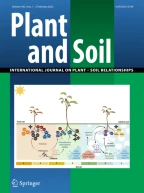Summary
The allelopathic effects of dried lantana shoot residues was examined on wheat, corn, soybean, Virginia pepperweed and velvetleaf on growth over a 30-day period. Significant differences in the growth of the test species were observed. Corn was the most sensitive and wheat was least affected by lantana residues. The other three species were intermediate in their growth response to lantana. Shoot lengths were affected in corn and velvetleaf while root length was reduced in all species except wheat. The shoot dry weights of wheat and soybean were not reduced by lantana residues. In the other three species there was a significant reduction of shoot dry weight due to lantana. The root dry weights of all the five species were reduced by lantana residue. The results demonstrated an overall rate dependent response of the plant species to lantana shoot residue concentrations.
Similar content being viewed by others
References
Achhireddy N R and Singh M 1984 Allelopathic effects of lantana (Lantana camara) on milkweed vine (Morrenia odorata). Weed Sci. 32, 757–761.
Achhireddy N R, Singh M, Achhireddy L L, Nigg H N and Nagy S 1985 Isolation and partial characterization of phytotoxic compounds from lantana (Lantana camara L.). J. Chem. Ecol. 11, 979–988.
AlSaadawi I S and Rice E L 1982 Allelopathic effects ofPolygorum aviculare L. I. Vegetational patterning. J. Chem. Ecol. 8, 993–1009.
Avers C J and Goodwin R H 1956 Studies on roots. IV. Effects of coumarin and scopoletin on the standard root growth pattern ofPhleum pratense. Am. J. Bot. 43, 612–620.
Bhowmik P C and Doll J D 1982 Corn and soybean response to allelopathic effects of weed and crop residues. Agron. J. 74, 601–606.
Fay P K and Duke W B 1978 An assessment of allelopathic potential in Avena germ plasm. Weed Sci. 25, 224–228.
Grummer G and Beyer H 1960 The influence exerted by species of Camelina on flax by means of toxic substances.In The Biology of Weeds. pp 153–157. The Biology of Weeds. Blackwell Scientific, Oxford.
Holm L G, Pucknett D L, Pancho J V and Herberger J P 1977 The World's Worst Weeds. Distribution and Biology. The Univ. Press of Hawaii, Honolulu.
Overland L 1966 The role of allelopathic substances in the ‘smother crop’ barley. Am. J. Bot. 53, 423–432.
Patrick Z A 1971 Phytotoxic substances associated with the decomposition in soil of plant residues. Soil Sci. 111, 13–18.
Phillips R L and Tucker D P H 1976 Evaluation of herbicides for lantana control in citrus groves. Proc. Fla. State Hortic. Soc. 89, 19–20.
Putnam A R and Duke W B 1978 Allelopathy in agroecosystems. Annu. Rev. Phytopathol. 16, 431–451.
Rice E L 1979 Allelopathy — an update. Bot. Rev. 45, 17–109.
Schon M K and Einhellig F A 1982 Allelopathic effects of cultivated sunflower on grain sorghum. Bot. Gaz. 143, 505–510.
Stachon W J and Zimdahl R L 1978 Allelopathic activity of Canada thistle (Cirsium arvense) in Colorado. Weed Sci. 26, 83–86.
Tomaszewski M and Thimann K V 1966 Interactions of phenolic acids, metallic ions and chelating agents on auxin induced growth. Plant Physiol. 41, 1443–1454.
Wadhawani C and Bhardwaja T N 1981 Effect ofLantana camara L. extract on fern spore germination. Experientia 37, 245–246.
Author information
Authors and Affiliations
Additional information
Florida Agricultural Experiment Station Journal Series No. 7166.
Research Associate and Associate Professor, respectively.
Rights and permissions
About this article
Cite this article
Mersie, W., Singh, M. Allelopathic effect of lantana on some agronomic crops and weeds. Plant Soil 98, 25–30 (1987). https://doi.org/10.1007/BF02381724
Received:
Revised:
Issue Date:
DOI: https://doi.org/10.1007/BF02381724
